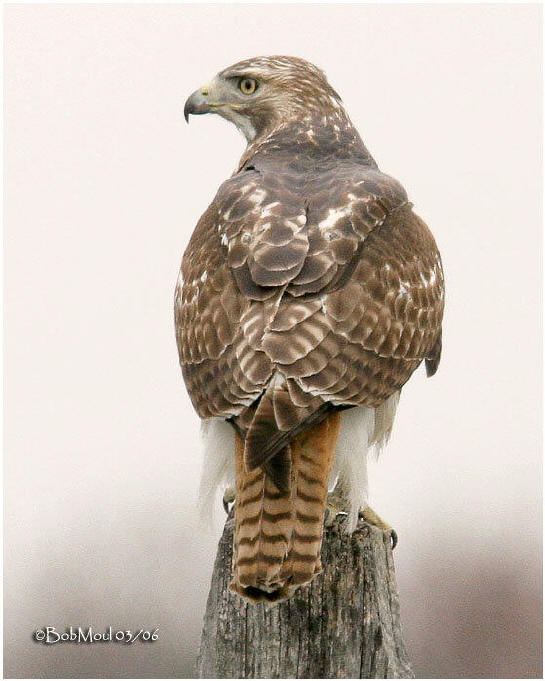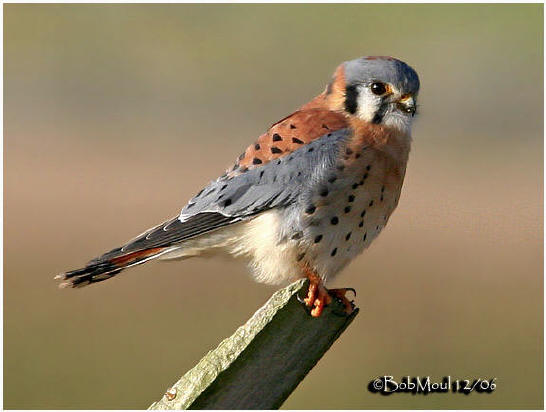|
Pets Large & Small
Birds of Prey (Raptors) along the Mason-Dixon
Rusty Ryan
Conservation Chairperson of the South Mountain Chapter
of the National Audubon Society
(Dec, 2011) Over the past twenty-five years of "birding", people have told me of a "hawk" they saw in their backyard or everyday travels. They are curious as to what the species is and they attempt to describe the bird to me in hopes I can identify by
description. I generally can identify the bird based on my knowledge of the raptor species of the Mason-Dixon. I trust you will learn more about these fascinating and beneficial predators.
Birds of prey all have in common a beak for ripping flesh and talons for grasping prey.
The probable raptors of this area include: Bald Eagle, Golden Eagle, Osprey, Red-tailed Hawk, Red-shouldered Hawk, Broad-winged Hawk, Northern Harrier, American Kestrel, Merlin, Peregrine Falcon, Sharp-shinned Hawk, Coopers Hawk, Goshawk, Turkey Vulture,
Black Vulture, Great-horned Owl, Barred Owl, Screech Owl, Barn Owl, Long-eared Owl, Short-eared Owl and Saw-whet Owl.
The most likely raptors to be encountered along the Mason-Dixon are as follows:
The Vultures
There are two vulture species in this area. Both vultures are excellent at soaring and taking advantage of the thermal air currents. They both are scavengers that feed primarily on carrion (dead animals). Both species lack feathers on the head. This lack
of feathers decreases the possibility of catching disease due to the vulture’s head buried in the rotten flesh of the carrion. Both species regurgitate food to their young as well as onto enemies when threatened.
The more common and best known is the Turkey Vulture (TV). The TV is the larger of the two and in flight appears to have longer tail. The adult TV can be distinguished from the Black Vulture by the reddish head. The immature TV does not have a reddish
head.
The Black Vulture is less common and tends to soar at higher altitudes than the TV plus they are more apt to flap wings more than the TV. The Black Vulture appears to have a stubby tail and has more white contrasting with the overall black coloration.
The local Christmas Bird Count conducted by the South Mountain Chapter of Audubon routinely reports over one hundred of the two each December.
The "Hawks"
Buteo – Buteo’s have a common feature of rounded wings and a rounded tail. These three species breed here.
Red-tailed (RT) – The RT is a very common raptor and is a year round resident. This bird is commonly seen in perched on a tree as you drive down the road. **Only the adult can be identified by the reddish tail.

Red Tailed Hawk
Red-shouldered – This hawk is near the size of a RT and tends to favor bottomlands near agricultural land. This hawk can be found year round.
Broad-winged – This crow sized hawk does migrate to South America. Hundreds and even thousands of these birds will migrate together and form a "kettle". I was lucky years ago to witness t a kettle at Hawk Mountain Sanctuary. This hawk prefers to feed on
cold-blooded animals and thus a main reason for this hawk to migrate to warmer climates.
Falcons - These raptors can be identified as a group by the narrow/pointed wings and narrow tail. The Kestrel is the lone breeder in the area.
American Kestrel (Sparrow Hawk) – A strikingly colored hawk the size of a plump Mourning Dove. The Kestrel is frequently seen perched on overhead wires and has a unique habit of hovering over an area in search of food. This bird has also adapted to nest
in artificial nest boxes. Amazingly, the Kestrel’s diet consists of insects as well as mice.

American Kestrel
Accipiters - Accipiters are woodland raptors who specialize in capturing prey (usually birds) in flight. They have short rounded wings with long narrow tail. The females are larger than males.
Sharp-shinned (Sharpie) and Coopers Hawk – The Sharpie is the size of a Bluejay while the Coopers is near crow size. It takes some skill to positively identify these two species. **The Sharpie and Coopers are the likely raptor that will be hunting and
harassing the birds at your feeder.
Northern Harrier (Marsh Hawk) - This grassland species is most often seen during the winter months. Field marks include a distinct white rump patch (rear end) and the habit of flying a few feet above the ground when hunting. The sexes can be separated
quite easily. The female is brownish and the male is gray. This bird is commonly observed flying low over the open grassy areas of the Gettysburg Military National Park.
Bald Eagle – Our national bird has made a great recovery since the years of decimation due to pesticide issues. When seen flying towards you, this bird appears to have wings straight across almost like a flying piece of 8 foot long lumber. Only the
breeding adult Bald Eagle has the distinctive white head and tail. The Bald Eagle is also a scavenger like the Vultures. A great place to observe the Bald Eagle is during the winter months along the Susquehanna River at the Conowingo Dam along U.S.1.
Osprey - The Osprey or fish eagle is a migrant. The Osprey has also rebounded nicely from the impacts of pesticide use of years ago. It may breed in the area but it does migrate to South America. This large raptor is about the same size as a Turkey
Vulture. The Osprey feeds almost exclusively on fish and has adapted to nesting on man-made platforms. Like the Kestrel, the Osprey is known to hover in search of food.
Owls
Great-horned Owl– This owl is the largest of the 4 most likely encountered owls. This bird is also the earliest nesting bird of the region since they will commence nesting in January. When someone thinks of a hoot owl, this owl sounds like an owl. This
owl is the only natural predator of the skunk.
Barred Owl – This large and dark eyed owl is the most diurnal and lacks the ear tufts of the Great-horned and Screech Owl. The Barred Owl frequents wooded bottomland habitat.
The Screech Owl is about the size of a robin and comes in two color phases - red and gray. The Screech Owl is a cavity nester and will utilize man-made nest boxes. The call of this owl is very non-owl like.
Barn Owl (the monkey faced owl) – This owl is long legged and light colored. This owl is a tremendous predator of rodents especially those rodents that cause farmers a problem. The Barn Owl is considered in decline in many places due to habitat loss but
the good news is that they will utilize artificial nest structures.
Identification
Learning how to identify raptors takes time. I recently took an identification quiz on the Internet and scored 94%. The quiz was based on photos. It is one thing to be able to identify a photo but put that bird in its natural environmental and in real
time and the challenge is magnified. Imagine now that the bird you’re trying to identify is moving. Imagine the bird is vocalizing and not visible. Imagine the bird is an immature versus an adult. All of these skills can be learned through practice. Visiting known raptor hot
spots and learning in the field is the best method of learning identification skills. Birding with knowledgeable folks in local bird clubs can be very helpful. One can only learn so much from field guides.
Places to view migrating raptors
Probably the most well known site would be Hawk Mountain Sanctuary near Kempton, PA. This sanctuary is the first ever in the world devoted to the conservation of raptors. Between August 15 and December 15, this site generally records 20,000 plus birds of
prey. The general rule of thumb: the greatest numbers of birds seen per day occur early in the season such as September and the most diversity occurs mid to late in the season. The sanctuary keeps a daily count, which can be obtained, via web site or by phone. Even if you don’t
see any raptor, which is very possible, the drive and visit to the sanctuary is still worth the trip.
Other well-known raptor sites include Waggoner’s (Wag) Gap and Rocky Ridge Park. Wag Gap is located along Rte. 74 north of Carlisle, PA. This site is considered the best site in eastern North America to view Golden Eagles in migration. Rocky Ridge Park
is located in east York near the Galleria Mall off of Rte. 30.
Useful Web sites:
- www.hawkmountain.org
- www.mdbirds.org
- www.pa.audubon.org
- www.ggro.org
- www.waggap.com
- www.virtualbirder.com
Rusty is the Conservation Chairperson of the South Mountain Chapter of the National Audubon Society
Read other articles by Rusty Ryan
|